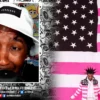[dropcap size=big]A[/dropcap] scene from a movie becoming associated with a particular song isn’t exactly an anomaly. Along the same lines, innovation in the realm of film isn’t a novel concept by any means. However, no one has mastered the ultimate duo of soundtrack and style in the way that Quentin Tarantino has over the last few decades.
It goes without saying that Pulp Fiction is Tarantino’s crowning achievement. Chock full of soon-to-be “A list” actors like Samuel Jackson and Bruce Willis, and Best Picture champ in Cannes upon its release, Pulp Fiction is a tour de force of a film if ever there was one. One of the most riveting, and arguably most confusing, aspects of Tarantino’s narrative (an aspect that he grew to be quite fond of) is the use of non-linear storytelling. Though jarring and brain-jumbling upon first viewing, the out-of-order scenes make for fantastic conversation, post-movie analysis, and at minimum 100 more watch throughs. Clearly, this tactic made a significant impact on Tarantino’s peers, as the years following Pulp Fiction were flooded with chronologically challenged cuts such as Seven, Eternal Sunshine of the Spotless Mind, and Memento.
An Iconic Intro
The film’s soundtrack, comprised of primarily surf rock and soul, demonstrates how instrumental an accompanying playlist can be for creating a specific mood. Not to mention, Pulp Fiction put surf rock back on the musical map. From the minute Dick Dale’s “Miserlou” kicks in to roll the credits, it’s evident that a cool yet zany film is about to grace the screen. Many movies bulldoze right through the opening credits, others lay them over the opening sequence, but Pulp Fiction transforms them into a funky introduction for the remaining two and a half hour run time.
From the minute Dick Dale’s “Miserlou” kicks in to roll the credits, it’s evident that a cool yet zany film is about to grace the screen.
When it comes down to it, the combination of surf rock and soul complimenting crime and black comedy seems a bit odd. Nowadays, films that exist within the genre feature pumping hip-hop, pulsing EDM, or in the case of the latter, maybe a quirky something or other. Regardless of whether or not Dusty Springfield’s “Son of a Preacher Man” or Chuck Berry’s “You Can Never Tell” belongs in Tarantino’s most memorable movie is still up for debate, but there’s no doubting that it stands as a testament to the power of a song in the right place at the right time.
Distracting With A Little Ditty
With the groovy song playing loud in the forefront (not hidden in the background as is the case in far too many films), and Michael Madsen’s goofy dance moves a close second, it’s almost a little bit easy to be distracted by the fact that one of the most famous torture scenes is playing out right in front of your very eyes.
Reservoir Dogs, Tarantino’s first foray into cinema, utilizes sound in a slightly different yet still entirely engaging manner. If “Jungle Boogie” by Kool and the Gang and “Busting Surfboards” from The Tornados act as ambient pieces, then Stealers Wheel’s “Stuck In The Middle With You” is a ploy for laughs. With the groovy song playing loud in the forefront (not hidden in the background as is the case in far too many films), and Michael Madsen’s goofy dance moves a close second, it’s almost a little bit easy to be distracted by the fact that one of the most famous torture scenes is playing out right in front of your very eyes. It simply cannot be anything other than pure mastery of movie when song choice can cause audiences to think back on an otherwise disturbing act as a quasi-fond memory.
A Love Letter To Kung Fu
Pulp Fiction sets the mood, Reservoir Dogs goes for gags, and the Kill Bill films (though mostly the first one) echoes the inhabitants of the Western and Japanese genres that came to be before Tarantino’s flicks were ever conceived. Nancy Sinatra’s “Bang Bang – My Baby Shot Me Down” and Luis Bacalov’s sweeping piece “The Grand Duel” serve as tribute to the West, while Meiko Kaji’s “The Flower Of Carnage” and Zamfir’s “The Lonely Shepherd” channel the Eastern-style works. Pulp Fiction‘s mash-up of soul and surf rock strikes a chord, and so does the melding of the music from West and East in Kill Bill.
On The Whole
In a Tarantino film, the soundtrack itself is a character, a concept tackled by few and far between, complete with style, personality, and a starring role in standout scenes.
Tarantino illuminates again and again, with the few films mentioned and practically every other film that exists within his domain, the fact that music in movies is severely underrated and often underthought, despite its invaluable contribution to the audience’s experience when utilized just right.
Through style and sound, Tarantino has proven himself to be a genuinely one-of-a-kind director and writer who has influenced countless others to say the very least. In a Tarantino film, the soundtrack itself is a character, a concept tackled by few and far between, complete with style, personality, and a starring role in standout scenes. Style and soundtrack are Tarantino’s signatures, and those who draw from his work (as he draws from others) find themselves echoing the importance of these signatures for good reason: you remember them.




